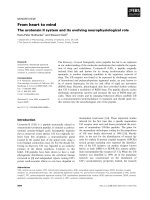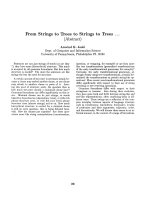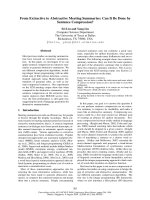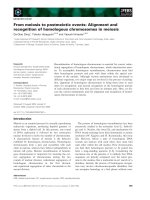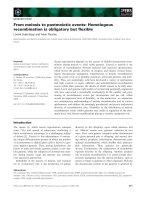Báo cáo y học: "From genomes to system" doc
Bạn đang xem bản rút gọn của tài liệu. Xem và tải ngay bản đầy đủ của tài liệu tại đây (58.78 KB, 3 trang )
Genome Biology 2004, 5:354
comment
reviews
reports
deposited research
interactions
information
refereed research
Meeting report
From genomes to systems
David I Ellis, Steve O’Hagan, Warwick B Dunn, Marie Brown and
Seetharaman Vaidyanathan
Address: School of Chemistry, University of Manchester, Sackville Street, Manchester M60 1QD, UK.
Correspondence: David I Ellis. E-mail:
Published: 28 October 2004
Genome Biology 2004, 5:354
The electronic version of this article is the complete one and can be
found online at />© 2004 BioMed Central Ltd
A report on the 2nd Conference of the Consortium for
Post-Genome Science (CPGS) ‘Genomes to Systems’,
Manchester, UK, 1-3 September 2004.
The second conference of the Consortium for Post-Genome
Science aimed to portray the breadth of studies in this field,
including genomics, transcriptomics, proteomics and
metabolomics. The emphasis was on the transition from
understanding at the level of each ’-omics to a more inte-
grated approach - that of systems biology. Systems biology
aspires to be more comprehensive than previous approaches
and to build predictive models that require powerful compu-
tation and the inclusion of meta data (information that
describes the attributes of the data, such as experimental
conditions). Six hundred delegates heard talks on diverse
topics ranging from structural genomics through protein
dynamics to pharmacogenetics and healthcare.
The plenary talk on networks by Albert-László Barabási
(University of Notre Dame, Indiana, USA) was both thought-
provoking and stimulating, dealing with fundamental princi-
ples and network function in both biological and
non-biological systems. The building blocks of networks
consist of nodes and connections, or links, and while certain
networks can be modeled effectively by connecting their
nodes with randomly placed links (according to the so-called
random network theory), others do not fit this model. The
highway system in the US could be considered a random
network, for example, in which nodes correspond to cities
and links to the connecting roads. In this network, each node
has approximately the same number of links and is therefore
‘typical’ of the others; the network can therefore be ‘scaled’.
In contrast, the air-traffic system consists of a few important
nodes that are well connected (so-called hubs) and many
others that are sparsely connected. The nodes in this
network are therefore ‘atypical’ and the network is ‘scale-
free’. Accidental failure of a number of nodes in a random
network can fracture the system into dysfunctional units.
But scale-free networks are more robust to such failure while
being highly vulnerable to attacks at the hubs. Many real-
world networks have this scale-free architecture, as they
continuously expand by the addition of new nodes. The new
nodes attach preferentially to already highly connected
nodes and there is a power-law distribution of connectivity.
Barabási pointed out that biological networks such as
protein-gene interactions in the genome, protein-protein
interactions in the proteome and biochemical reactions
within the metabolome, are scale-free. In a metabolic
network, for example, the nodes are the chemicals (sub-
strates) and the links the biochemical reactions, and meta-
bolic networks have been shown to be scale-free in all three
domains of life - archaea, bacteria and eukaryotes. In the
proteome, where proteins (the nodes) are preferentially
attached to other proteins, the origin of this scale-free topol-
ogy is gene duplication, which has the consequence that a
new protein tends to interact with the same proteins as the
protein product of the original duplicated gene. Proteins
with more interactions are therefore more likely to get a new
link from other proteins. Barabási described how these
complex networks are robust and maintain their basic func-
tions even when subjected to errors and failures, such as cell
mutations. He also discussed modularity in cellular net-
works, based on the hypothesis that biological functions are
‘bolted’ together into modules, an idea that is supported by
metabolic data, for example in Escherichia coli, and suggests
a hierarchical organization of metabolic networks. Barabási
then went on to describe system-level experimental analysis
of the entire spectrum of E. coli metabolism, including the
global flux organization of the metabolic network, and
concluded with a description of life’s complexity pyramid
(see [ />Proteomics and mass spectroscopy
Two sessions on proteomics dealt with quantitative aspects,
protein dynamics and post-translational modifications.
Peter Roepstorff (University of Southern Denmark, Frederi-
cia, Denmark) presented highlights from studies in his labo-
ratory applying two-dimensional gel electrophoresis and
matrix-assisted laser desorption ionization mass spectrome-
try (MALDI-MS) to the study of protein expression. In his
experience, offline coupling of protein or peptide separation
and MALDI-MS (and tandem MS, MS/MS) identification
are currently more efficient for expression proteomics than
online coupling of separation and MALDI-MS (for example,
direct coupling of liquid chromatography and mass spec-
trometry, LC-MS). And tandem MS with MALDI-QToF
(quadrupole time-of-flight) is more efficient than MALDI-
ToFToF for detecting and analyzing protein modifications.
Roepstorff presented studies on serum glycoproteins, in
which 62 glycosylation sites on 37 glycoproteins were
detected using MALDI-MS/MS coupled with lectin-affinity
purification. Describing the application of proteomic
approaches to the study of flagellar proteins in Try-
panosoma brucei, Simon Gaskell (UMIST, Manchester, UK)
showed how selective fragmentation of carboxyl-containing
residues and subsequent analysis by MS/MS can be useful in
protein identification.
Alan Marshall (Florida State University, Tallahassee, USA)
highlighted the capabilities of Fourier-transformed ion
cyclotron resonance (FT-ICR) MS, the fastest-growing MS
sector (growing 25% per year in terms of output), in pro-
teomic studies, with resolutions that allow a 1000 Da
peptide to be distinguished from a peptide of 1000.0003 Da.
He showed its utility in identifying biomarkers for
Alzheimer’s disease and renal disease, with MS/MS strate-
gies based on electron capture dissociation and infrared
multiphoton dissociation.
A detailed account of current proteomic concepts was pre-
sented in the plenary session by Ruedi Aebersold (Institute
for Systems Biology, Seattle, USA), who described the appli-
cation of quantitative isotope labeling strategies in protein-
complex studies for understanding protein-interaction
networks. He discussed the current limitations of protein-
complex analysis and showed how for any protein, the proba-
bility of its being complex-specific can be calculated from its
isotope-coded affinity tags (ICAT) ratio. Aebersold high-
lighted the current limitations of liquid chromatography
MS/MS approaches and the complexities involved in analyz-
ing multiple peptides for protein identifications, suggesting
that perhaps we should look for “proteotypic peptides”, with
the aim of identifying and quantifying precisely one peptide
per protein that uniquely identifies that protein. He discussed
the construction of a nonredundant database of proteotypic
peptides for the human proteome; this database currently
covers 20-25% of human genes and consists of 2.5 million
MS/MS spectra. He also highlighted the potential for the
development of arrays of proteotypic peptides.
Most proteomic investigations currently concentrate on
protein expression patterns. But this is now changing with
the realization that there is more to proteomics than mere
expression data. Rob Beynon (University of Liverpool, UK)
highlighted the importance of studying the nuances of
protein dynamics, with respect to the synthesis and degrada-
tion of proteins in the cell. He showed, using studies in yeast
and chicken as examples, how stable-isotope-labeled amino
acids and MS can be used to study protein dynamics.
The importance of employing mathematical tools in the bio-
sciences, in particular in studying protein-protein interac-
tions, was highlighted by Ian Humphrey-Smith (University
of Utrecht, The Netherlands). He presented data illustrating
the complexities of comprehending and analyzing proteomes
with respect to protein interactions - there are an estimated
9.6 million protein-protein interactions in E. coli alone. He
discussed how biomolecules are never specific for a single
target and how a single peptide will never be enough to
always identify a unique protein, immunologically speaking.
Mathias Uhlen (The Royal Institute of Technology, Stock-
holm, Sweden) discussed systematic exploration of the
human proteome using a combination of high-throughput
generation of affinity-purified antibodies, involving the
cloning and expression of protein epitope signature tags
(PrESTs), with protein profiling using tissue arrays. Analysis
of the putative gene products of human chromosome 21
using this strategy was described. The results suggest that
the strategy can be used in profiling proteomes and in sub-
cellular localization studies on a genome-wide scale.
A particularly well attended session on metabolomics heard
the announcement of a new journal, Metabolomics, to be
published in January 2005 by the Springer Verlag (New
York, USA). Douglas Kell (University of Manchester, UK)
described a range of metabolomic investigations in different
organisms, including the application of gas chromatography
MS and machine learning in the search for new diagnostic
biomarkers for human disease states. He concluded that
metabolomics has great potential in both clinical and non-
clinical applications and will play an important and integral
part in systems biology.
Bioinformatics and modeling
A strong motivation in informatics research is the retrieval of
buried information from both new and existing data, thus
providing inductive insights leading to new knowledge. Use
of existing, often analogous, data also helps avoid duplication
354.2 Genome Biology 2004, Volume 5, Issue 11, Article 354 Ellis et al. />Genome Biology 2004, 5:354
of experimental work, in that new experiments can be more
focused. The other trend in informatics is the need to inte-
grate diverse information to obtain a more holistic descrip-
tion of the biology under investigation.
Arun Holden (University of Leeds, UK) described an ambi-
tious project aimed at modeling the probability of death from
sudden cardiac arrest due to mutations in cardiac ion chan-
nels, in which modeling is based on a representation of cellu-
lar protein dynamics, a histologically detailed tissue model
and a detailed anatomical model of the heart. This complex
system was used to understand the mechanism of onset, per-
sistence and termination of arrhythmias. Arrhythmias were
shown to correspond to large-scale spiral waves propagating
throughout the cardiac tissue, and the extent of meander of
the spiral-wave focal point was found to be of prime impor-
tance in determining the duration of the arrhythmia. This
model was successful in explaining the qualitative effects on
the likelihood and duration of arrhythmias of different gene
mutations corresponding to K
+
and Na
+
channel inhibition.
The simulation/modeling approach used, which has become
known as ‘virtual tissue engineering’, appears to be one of the
first attempts to understand the effects of processes at the
level of cellular biochemistry on macro-scale function
through integrating knowledge of structural, anatomical,
tissue and cell characteristics and behavior.
David Westhead (University of Leeds) presented his group’s
work on the design of the metabolic reconstruction software
metaSHARK, together with case studies on the shikimate
pathway in Plasmodium and on the metabolism of Eimeria
tenella, the cause of coccidiosis in poultry. Metabolic recon-
struction seeks to elucidate an organism’s complement of
enzymes and metabolic reactions from knowledge of the
genome sequence, using information from protein databases
and known metabolic mechanisms. The knowledge base need
not be confined to the particular organism under study, as the
software is designed to search genome data from related
species for protein and enzyme analogs while taking into
account sequence differences. The metaSHARK suite of pro-
grams includes SHARKdb, an object-orientated database of
metabolic information stored in a form (Petri Net) that
makes computation easy; SHARKbuilder, an automated
system for metabolic reconstruction from unannotated
genomic data, which uses amino-acid conservation informa-
tion to search for genes with significant similarity to model
enzyme sequences from other organisms; and SHARKview
(see [ a web-based
graphics tool enabling visualization of both database con-
tents and metabolic reconstruction results.
Using annotated SWISS-PROT data, metaSHARK per-
formed well compared to existing reconstruction software.
In the shikimate pathway study in Plasmodium, only one of
the seven pathways is annotated in the published P. falci-
parium genome. A metaSHARK search gave evidence for a
bifunctional enzyme encoding both 5-enolpyruvylshikimate-
3-phosphate (EPSP) synthase and shikimate kinase activi-
ties, corresponding to the two precursor pathways of the
already identified chorismate synthase. Eimeria tenella
metabolism is currently poorly characterized: using raw
Eimeria DNA data, metaSHARK gave better identification of
potential metabolic function than did methods that are
based on PRIAM, an existing method for automated enzyme
detection from genome sequences, based on the classifica-
tion of enzymes. Thus, metaSHARK should become an
important tool for obtaining new knowledge about metabolic
processes from unannotated eukaryotic genomes.
The final plenary lecture was given by Steve Oliver (Univer-
sity of Manchester) who discussed the integration of the dif-
ferent ‘-omics’ technologies highlighted during the
conference and their application to the study of Saccha-
romyces cerevisiae. He described the generation of commer-
cially available single-gene knockout mutants, highlighting
the replacement of single genes with a kanMX deletion cas-
sette that has no genetic effect on the organism and is
marked by two unique 20 bp ‘barcodes’. In competition
experiments using such mutants, heterozygotes mutant for
each of the essential genes (1,500 mutants) were studied to
determine the effect on fitness, as determined by growth rate,
of each of these genes. Haploinsufficient genes were identified
and were shown to exert a high level of control over the path-
ways in which they participate or regulate. Oliver described
work following on from this, using continuous chemostat cul-
tures to study the effect on different nutrient-limiting condi-
tions (carbon, nitrogen, phosphate and sulfate) and dilution
rates on the yeast metabolome, proteome and transcriptome.
He described analysis of the endometabolome (intracellular
metabolites) and exometabolome (metabolites secreted into
the culture medium) using direct injection electrospray MS,
analysis of the proteome by two-dimensional gel electrophore-
sis/MALDI-MS and analysis of the transcriptome by microar-
rays, and showed how the effects of different nutrient-limiting
conditions and dilution rates could be separated for all
these systems using principal components analysis. Applica-
tion of a systems biology approach using all ‘ome data can be
assumed to be the next stage. The next conference of the
CPGS is scheduled for Spring 2006 in Manchester; details are
available online at [ />conference_2004/index.html].
comment
reviews
reports
deposited research
interactions
information
refereed research
Genome Biology 2004, Volume 5, Issue 11, Article 354 Ellis et al. 354.3
Genome Biology 2004, 5:354
